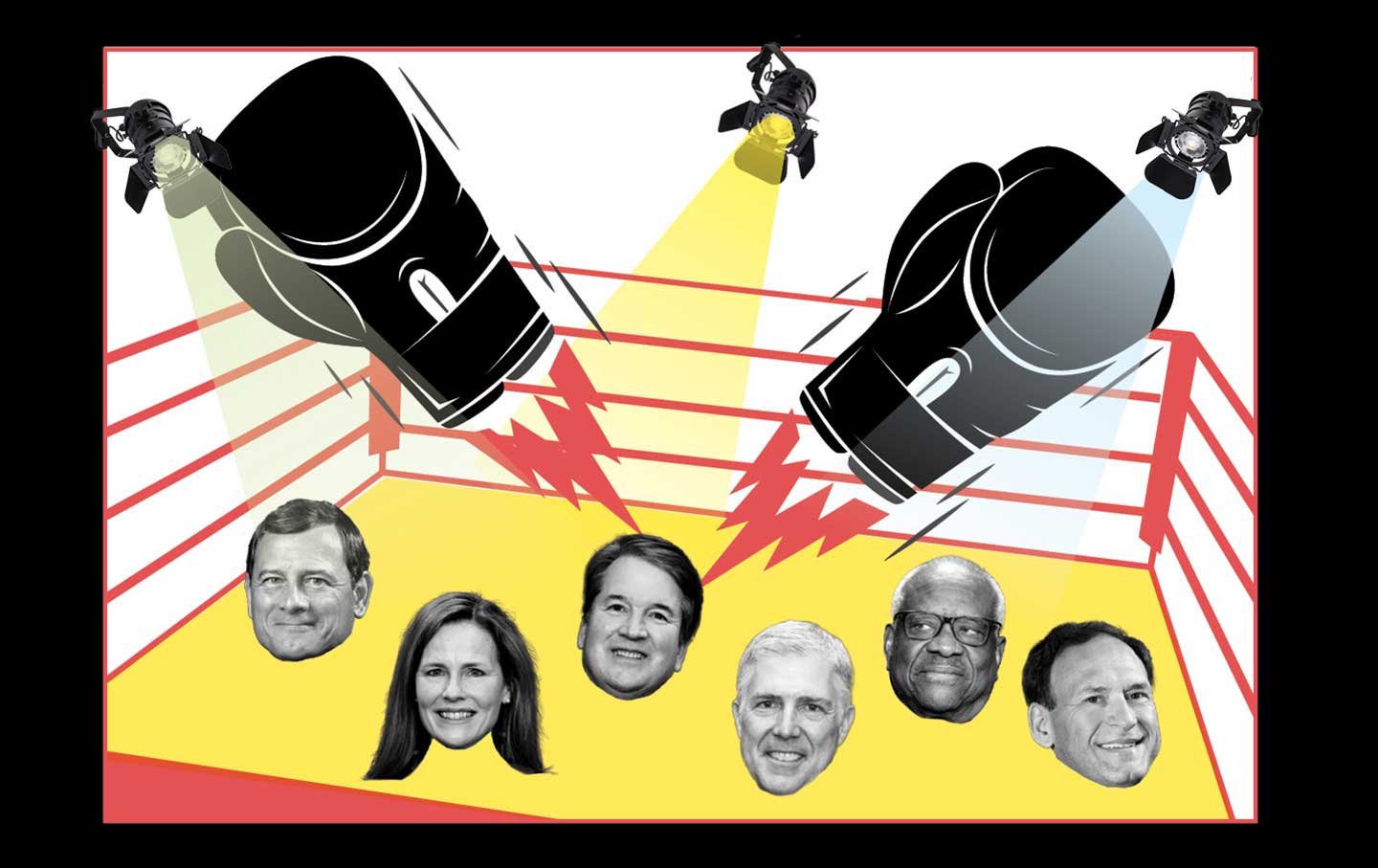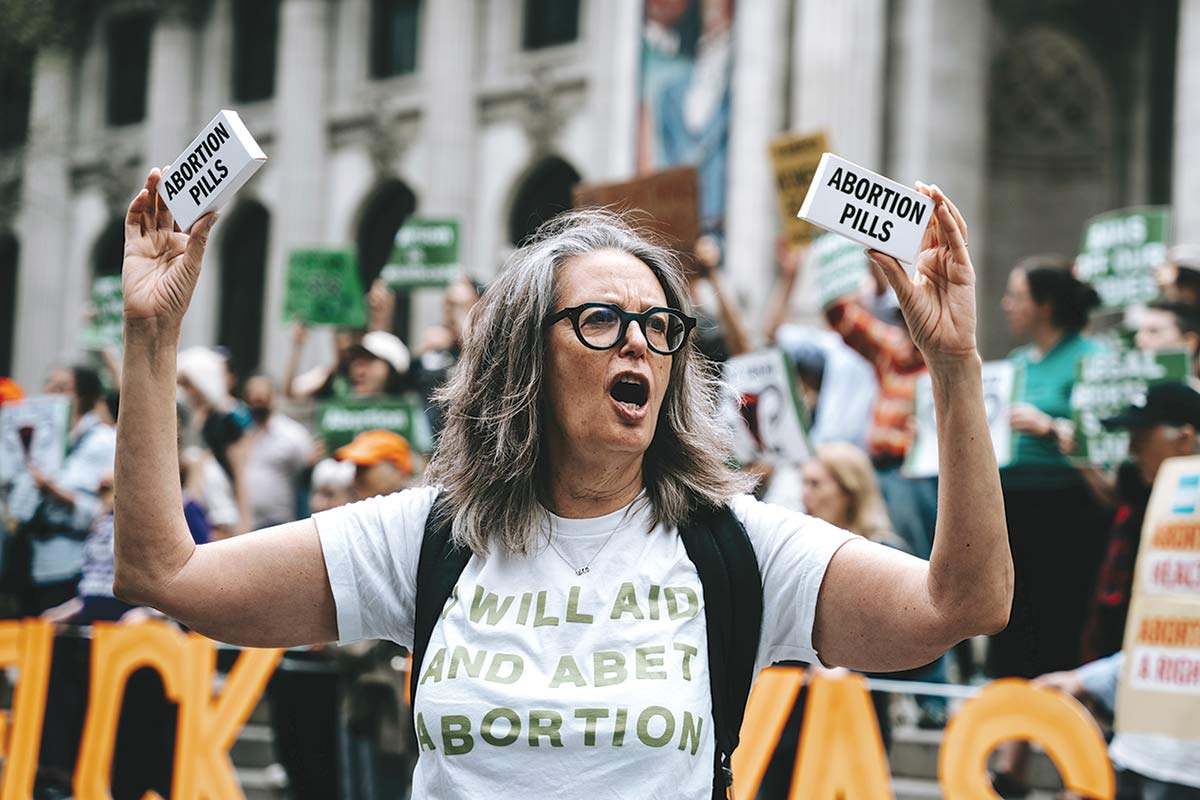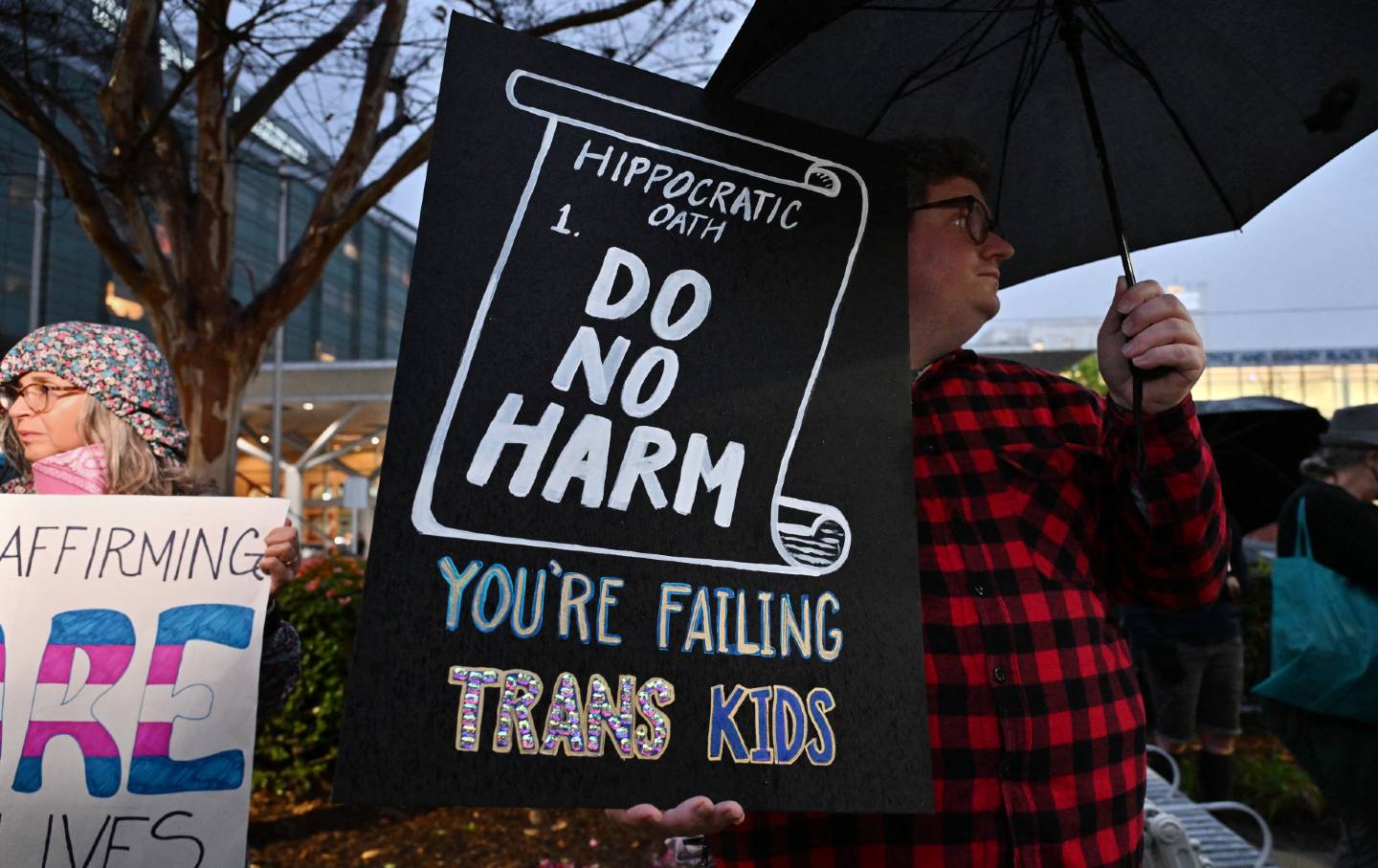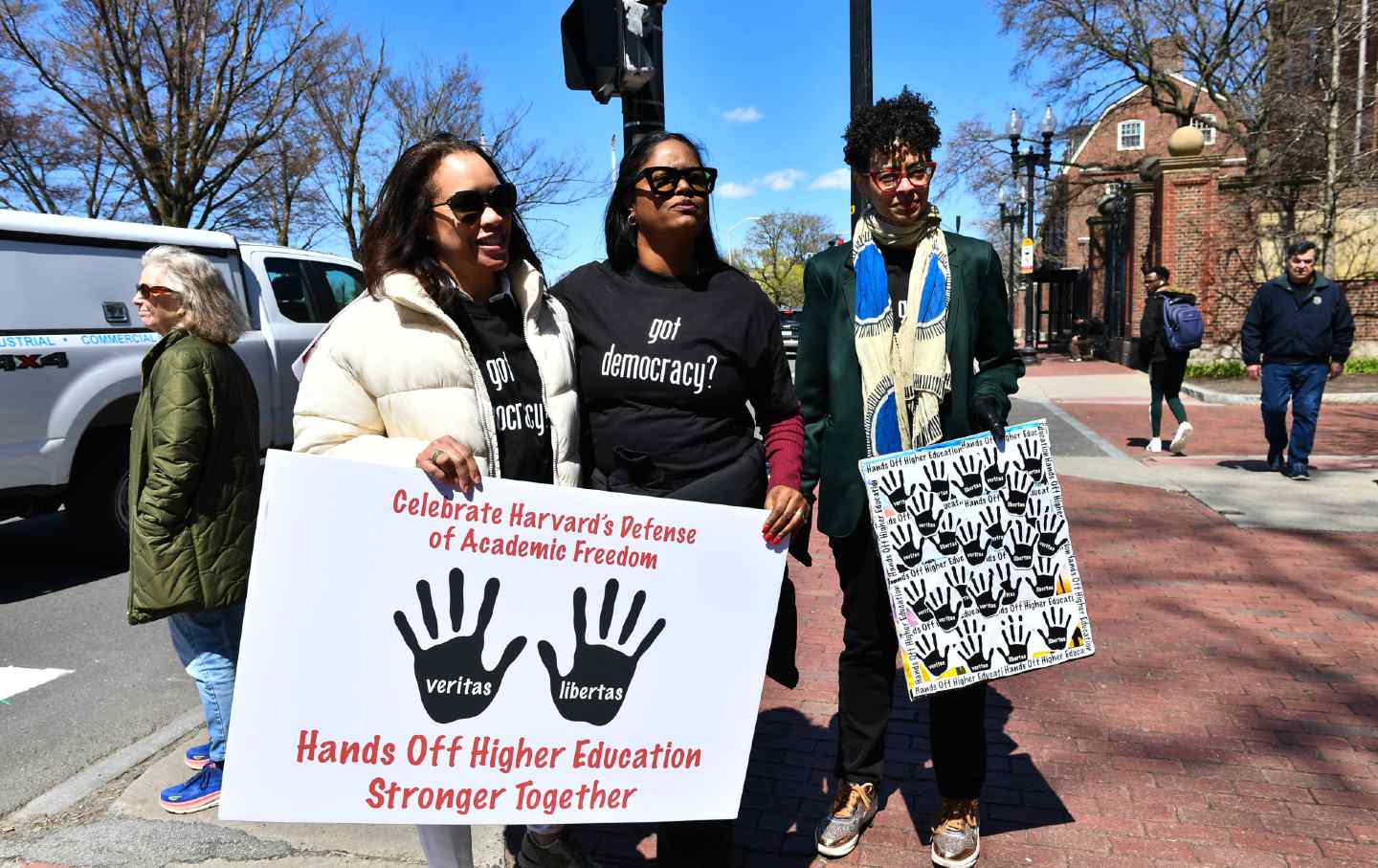Supreme Court Preview: This Term, It Can Always Get Worse
With the liberals thoroughly outmatched, the upcoming term will not be a battle between right and left—it will be a battle between shades of extremism.

The Supreme Court of the United States will get back to work on October 2. As is now tradition, the 2023–24 term will give the Republican-appointed justices on the court plenty of opportunities to revoke rights, promote gun violence, and make the world safe for wealthy white men and nobody else. As is now also tradition, the elected branches of government—as well as the Democratic Party—will do nothing to stop those six conservative justices from imposing their far-right cultural agenda upon us all.
The upshot is that this Supreme Court term will not be a debate between conservative and liberal legal viewpoints. (There are no liberal viewpoints that have any chance of prevailing in the face of the court’s conservative supermajority.) Instead, this term will be about which flavor of conservatism gets shoved down our throats. Will it be the kind that delivers conservative policy victories while preserving the idea of normal constitutional order, as favored by Republican Party operative and Chief Justice John Roberts? Or will it be the search-and-destroy jurisprudence—favored by justices like Clarence Thomas and Samuel Alito—that is more concerned with cultural domination than logical (or factual) legal rulings?
It’s not at all clear which version is better. Roberts’s lethal-injection cocktail might at first seem more palatable, until you remember that it’s designed to mask the horror of what he’s doing so that the public never reacts. The Thomas-Alito firing squad is more destructive, but their barbaric methods leave no doubt as to their true intentions. Either way, all the liberal justices can do is offer a well-written obituary for the victims of conservative legal aggression.
We will see this conservative family feud play out most obviously when the court considers the cases that came up through the United States Court of Appeals for the Fifth Circuit, the most reactionary court in the country. The Fifth Circuit is a conservative judicial fiefdom: 12 of its 17 judges were appointed by Republican presidents, including six by Donald Trump. Aided by those Trump judges, the Fifth Circuit has largely ceased to be a “normal” right-wing appellate court and has become an incubator for Christofascist legal ideology. Judges like Kyle Duncan and James Ho write legally dubious and morally unconscionable opinions that are openly hostile to women, LGBTQ people, and any law signed by Barack Obama or Joe Biden, all while treating established constitutional precedent with the kind of respect a dog treats a fire hydrant.
Ever since it effectively overturned Roe v. Wade a year before the Supreme Court did (by upholding Texas’s facially unconstitutional “bounty hunter” law, which enables private citizens to sue anyone who helps another person get an abortion), the Fifth Circuit has gone fully rogue. This term, the Supreme Court will hear at least five cases that were appealed after the Fifth Circuit adopted ludicrous legal theories to make sure that the conservative cultural agenda prevailed.
In Alliance for Hippocratic Medicine v. Food and Drug Administration, the Fifth Circuit upheld restrictions on the sale of the abortion pill mifepristone on the theory (among others) that women who take the medication might be too sad to know what’s good for them. In US v. Rahimi, it ruled that domestic abusers shouldn’t lose access to their guns. In Securities and Exchange Commission v. Jarkesy and Consumer Financial Protection Bureau v. Community Financial Services Association of America, it effectively ruled that the agencies in question don’t have the right to exist or to enforce regulations. And in Campos-Chavez v. Garland, which is this year’s version of the Fifth Circuit’s annual Kafkaesque assault on immigrant rights, the court ruled that a man could be deported for failing to appear at his immigration hearing, even though his notice to appear contained neither the time nor the place of that hearing.
I’d rather try my luck arguing my way out of hell with Satan than arguing that the Constitution promises equal justice for all in front of the Fifth Circuit. At least Satan is bound by rules. The lower courts are bound only by the Supreme Court, and during this term we will see whether that means anything at all.
The Fifth Circuit is an open flame burning through constitutional democracy, and the Supreme Court will spend the next nine months debating whether to throw gas or water on the conflagration. But even if the justices decide that they’ve had enough of the Fifth Circuit’s unconstitutional shenanigans, there are still plenty of other cases that will allow the court’s conservative supermajority to continue its internecine fight over its extremist restructuring of constitutional law. Below are my picks for the six most important cases currently docketed—or likely to be docketed—for review by the Supreme Court.
I am once again asking the elected branches of government to stop the Supreme Court before it’s too late.

Alliance for Hippocratic Medicine v. Food and Drug Administration
Date of Hearing: TBD
The most risible piece of constitutional tripe coming out of the Fifth Circuit hasn’t actually been accepted for review by the Supreme Court as of this writing—but it very likely will be. The case in question is Alliance for Hippocratic Medicine v. Food and Drug Administration, better known as the abortion pill case. This past April, federal district court Judge Matthew Kacsmaryk banned the abortion drug mifepristone. That ruling was blocked by the Supreme Court pending a full appeal to the Fifth Circuit. In August, the Fifth Circuit issued its ruling, and while it did not ban the drug outright, it rolled back access to pre-2016 levels, overturning FDA rules that allowed the pill to be prescribed via a telehealth appointment, without an in-person consultation, and to be sent through the mail. The Department of Justice appealed in early September, and the Supreme Court is expected to decide soon whether to take the case. Assuming it hears the appeal this term, we can expect a final ruling sometime in June 2024.
Popular
“swipe left below to view more authors”Swipe →The Supreme Court’s decision will have huge implications for reproductive rights: Well over half of the abortions in the United States are medication abortions, which rely, in part, on mifepristone—a fact that the forced-birth judicial complex is well aware of. But in its zeal to impose Christian theocracy on public health decisions, the Fifth Circuit adopted legal theories that sound cribbed from the Salem witch trials instead of constitutional law.
The plaintiffs in this case are a group of anti-abortion doctors and “medical” organizations who have neither taken nor prescribed mifepristone. Their standing to challenge the FDA is based partly on the argument that women who have taken the abortion pill are too ashamed to sue on their own behalf. What’s more, these doctors claim that they themselves have been harmed by mifepristone—specifically, that they have suffered the “aesthetic injury” of being deprived of the opportunity to see and work with babies. The implication that women should be forced to bring pregnancies to term against their will because people who do terminate their pregnancies are too sad, depressed, or “hysterical” to know what’s good for them is offensive. It’s not law; it’s the colonization of people’s bodies by men who view women as beasts of burden.
Even if you are someone who can’t respect the right of people to control their own bodies, you should know that a Supreme Court ruling upholding the Fifth Circuit opens the door for random judges in Texas to make decisions about every single drug or therapeutic that enters your body. The science is well-established: Mifepristone is safe and effective. It has been approved not only in this country but all over the world for decades. The idea that a panel of judges—most of whom couldn’t sound out the words on an organic chemistry test, much less pass it—should overrule the decision of experts at the FDA is simply ludicrous. That’s the reason the broken clock that is Big Pharma is all in with the FDA on this case. The question is simply whether drug approval should be done by experts or by a judge who flunked out of seminary before hooking up with Leonard Leo and Donald Trump.
If the Supreme Court goes for these anti-scientific arguments, the results will quickly be repurposed by the Fifth Circuit to attack other medications that the judges think women are too fragile to resist themselves. The mifepristone case isn’t just an attack on the abortion pill; it’s the foundation of a future assault on contraceptives.
United States v. Rahimi
Date of Hearing: NOVEMBER 7
Most people will talk about Rahimi as if it’s only about guns and the battle is once again over the scope of the Second Amendment. While that’s not wrong from a legal standpoint, this case is really about one thing: killing women. It will tell us how comfortable the conservative justices are with murdering women and how easy they want to make it for men to do so.
At issue is whether people who are subject to a restraining order for domestic abuse—or for harassing, stalking, or threatening their intimate partners—should lose their gun rights. The US criminal code says that people subject to such restraining orders can have their guns taken away. The Fifth Circuit Court of Appeals says that the law violates the Second Amendment.
We know that taking guns away from domestic abusers saves lives. That’s not a legal theory but an empirical fact: A woman is five times more likely to be murdered by an intimate partner when her abuser has access to a gun than when the abuser does not. If the Supreme Court upholds the Fifth Circuit in this case, more women will die.
We are staring at a dystopian future wherein the Supreme Court will neither give women access to life-saving abortions nor allow them to protect themselves from the predators who hunt them. That’s not just conservative hypocrisy; it’s active evil.
Conservatives try to mask the horror of what the Fifth Circuit has done here by making a due-process argument. They say that a restraining order is vastly different from a criminal conviction and that people should not have a fundamental constitutional right taken away from them without the full benefit of a trial. There is a version of this argument I could agree with: I don’t, for instance, think people should lose their voting rights based on a prosecutorial indictment.
But what conservatives ignore is that a restraining order is far from a mere allegation. A complaint is filed, a judge reviews it, and the defendant has an opportunity to object. There is a process. Restraining orders are not, as Judge James Ho suggested in his concurrence to the Fifth Circuit ruling, a “tactical device” used by spurned women to get back at their former lovers.
I don’t think the Supreme Court will go for Ho’s and the Fifth Circuit’s framing of the issue. Alito will, and probably Thomas, but I think the other conservatives will blink at the prospect of rearming abusers. Even though a restraining order is not the same as a criminal conviction, I just can’t believe that Roberts and Amy Coney Barrett want this much blood so directly on their hands. And I don’t think the liberals will use this case to make some larger point about pretrial detention or the revocation of voting rights to felons. The Fifth Circuit has to lose here—I can’t bear to imagine the consequences if it doesn’t.

Alexander v. South Carolina State Conference of the NAACP
Date of Hearing: OCTOBER 11
After the 2020 Census, South Carolina’s Republican-controlled Legislature redrew the maps for the state’s seven congressional districts. Predictably, the maps were heavily gerrymandered to produce safe Republican districts: South Carolina is over 25 percent Black but has precisely one Black representative (James Clyburn), who’s also the only Democratic member of the state’s congressional delegation.
The NAACP sued South Carolina over its maps on October 12, 2021, and a three-judge federal district court panel found that one district (CD-1, currently held by Representative Nancy Mace) was indeed an unconstitutional racial gerrymander: Legislators had drawn tens of thousands of Black voters out of the district to make it whiter, and therefore safer for Republicans.
The Republican legislators appealed the decision directly to the Supreme Court, arguing, among other things, that the district court “failed to apply the presumption of good faith” when analyzing the maps. I’m not making that up: The principal legal argument made by South Carolina Republicans is that they should be given the benefit of the doubt when they (checks notes) significantly diminish the voting rights of Black people in their state. They argue that they should be believed when they say they drew the Black voters out of CD-1 because they were trying to make a more Republican district, not a whiter one.
All of this is the natural result of Chief Justice John Roberts’s ruling in 2019’s Rucho v. Common Cause. In that case, Roberts said that political gerrymanders are “nonjusticiable,” meaning that federal courts cannot stop states from doing them, but that “racial” gerrymanders are still unconstitutional. I said at the time (and have, figuratively, every day since) that Roberts’s formulation was unworkable, both because of the high overlap between Black voters and Democratic voters and because state legislatures rarely write “Also, we hate Black people” in the margins of their maps. After Rucho, I predicted, every racist gerrymander would be sold as a political gerrymander by the people doing the gerrymandering, and, well, here we are.
I don’t know if Roberts will plant his head in the sand and declare South Carolina’s redrawn CD-1 a political gerrymander, or if he will call it a racial gerrymander in an attempt to prove that there is some definable principle behind his Rucho decision. But I do feel confident that Ketanji Brown Jackson, who was not on the court in 2019, will use this opportunity to shame the devil and relitigate the issue of whether racism happens only when Republican legislators are willing to admit to it.
O’Connor-Ratcliff v. Garnier
Date of Hearing: OCTOBER 31
Lindke v. Freed
Date of Hearing: OCTOBER 31
These two cases address a question on which, I’m sad to say, I think we do need official Supreme Court answers: Which First Amendment principles—if any—apply when elected officials use their personal social media accounts to quiet debate or cut off speech? Personally, I don’t know, and public officials certainly don’t either. So we kind of need the Supreme Court to tell us, and then we can just roll with it.
In O’Connor-Ratcliff, two members of a school board in Southern California created public Facebook and Twitter accounts to disseminate some publicly relevant information—and then blocked a couple of parents who were using those social media platforms to complain about them. The Ninth Circuit Court of Appeals ruled, in July 2022, that the public officials’ decision to block the parents constituted a state action, and thus that those officials violated the First Amendment’s protection of free speech.
That determination would not necessarily have been reviewed by the Supreme Court, except that, a month earlier, in June 2022, the Sixth Circuit Court of Appeals had ruled in Lindke that James Freed, the city manager of Port Huron, Mich., could block a person who was leaving critical comments on social media about Freed’s handling of the Covid-19 pandemic.
The Supreme Court took up both cases to resolve the conflict, but this is a case that will affect every public officeholder, from city aldermen to the president of the United States. It is not as weighty as the potential First Amendment issues surrounding President Biden’s plan to curb disinformation on social media (a case that is not yet ready for Supreme Court consideration), but it does have massive implications for how we are allowed to interact with our leaders.
It seems to me that posting “You Suck! And your mother smells of elderberries!” to a public official’s social media account is in fact exactly the kind of speech the First Amendment was designed to protect. And yet, telling a school board member that they have to subject themselves to the very worst of what the white wing has to offer every time Fox News targets them for supporting the teaching of actual history feels a little unfair to me. And remember, the conservatives on the Supreme Court act like political protest on the streets outside their homes is akin to a threat to their personal safety, so they already think the First Amendment is irrelevant in some respects.
I have no idea how the court will rule, but I bet Samuel Alito will write separately to say that every official can be criticized—except conservative judges, who can only be spoken about in reverent tones in The Wall Street Journal.

Loper Bright Enterprises v. Raimondo
Date of Hearing: TBD
The Supreme Court already has more power than any panel of unelected functionaries should have in a democratic republic, but this case could result in the court granting itself even greater authority. We’d honestly be better off just kneeling to the justices as they walk through the streets than letting Neil Gorsuch and Clarence Thomas do what they want to do with this case.
The underlying issue in Loper is deceptively banal: A conglomeration of fishing companies is suing the National Marine Fisheries Service (an agency within the Department of Commerce) over a rule that requires fishing companies to pay the costs for observers who make sure those companies are in compliance with regulations. I don’t care who pays for the monitors. I don’t care about the eight or nine stuffed suits who do care about who pays for the monitors. And I don’t care about the rule. I do care, however, about who gets to make the rule.
The legal concept spelling out who gets to make the rules is known as “Chevron deference.” To explain Chevron deference, a quick refresher course in American civics may be in order: The legislative branch makes the laws, the executive branch enforces them, and the judicial branch interprets them. Republicans would like the lesson to stop there, but often the executive branch has to issue additional orders to enforce the laws passed by Congress. We sometimes call these orders “rules” or “regulations.”
Chevron deference is the legal concept that courts should defer to the interpretation of the executive branch and its regulatory agencies when assessing the will of Congress. Its name stems from the 1984 case Chevron v. Natural Resources Defense Council, because that’s where the concept was best articulated. It’s necessary because even the most textually straightforward laws can result in wildly different interpretations. Congress could pass a three-word law—“Clean water now!,” for example—and we’d still need additional regulations telling us what “clean” and “now” and even “water” mean in practice. Chevron deference says that we should go with the interpretation of the executive branch and its experts instead of some random judge in Washington, D.C., unless the executive branch is clearly overstepping its bounds or maligning the will of Congress.
You can see why Republicans hate Chevron deference: Deferring to facts and expertise is not their thing, especially when the pencil-necked geeks who actually study the issues are forever getting in the way of their smash-and-grab capitalism. You can also see why conservative judges hate Chevron deference: It takes power out of the hands of the courts and places it in the hands of the president, whom the people actually elected. Jurists like Neil Gorsuch, who has spent a large part of his career railing against Chevron deference, claim they want to return power to Congress instead of the executive, but that’s a lie. Without Chevron deference, it won’t be Congress making the detailed-oriented decisions about, for example, who has to pay for fish watchers; it will be the courts who assume that power. Getting rid of Chevron deference will allow the six conservative justices on the Supreme Court to essentially deregulate the entire country.
Loper explicitly asks the court to overturn Chevron. It’s the case Gorsuch has been waiting for. Thomas, Alito, and Kavanaugh have all been critical of Chevron in the past and also probably believe that Supreme Court justices should be outfitted with golden crowns. Roberts loves giving judges more power as well, but Chevron is a 40-year-old precedent, so there’s a chance he won’t vote to overturn it. This case could very well come down to Barrett’s beliefs about the administrative state. Maybe the best thing I can do is pray.
Moore v. United States
Date of Hearing: TBD
Somewhere, on some super-yacht or in some luxury fishing lodge, billionaires have been talking about this case with the Supreme Court justices they’ve purchased. That’s because Moore is a direct challenge to the federal government’s power to tax, as articulated by the 16th Amendment.
The 16th Amendment was ratified in 1913 to fix a frankly idiotic federal tax scheme cooked up by the founding fathers. The amendment allowed the federal government to impose a direct tax on income “from whatever source derived.”
At issue in Moore is the “source” of taxable income. In 2017, Donald Trump authorized a “repatriation tax,” which forced US taxpayers with shares in foreign companies to pay a onetime tax on their portion of the foreign profits. The plaintiffs in Moore own shares in an Indian company, and though that company recorded profits, it did not pay out dividends on the shares. The plaintiffs argue that those shares are not a source of income until the profits are distributed, and thus they can’t be directly taxed under the 16th Amendment.
Moore is not important because of the hokey repatriation tax; rather, it is important because it allows the Supreme Court to preemptively kill any kind of “wealth tax” or “billionaires’ tax” should the Democrats ever get their heads out of their asses long enough to pass one. That’s because a wealth tax does not look at realized income like stock dividends; it looks at the overall value of a taxpayer’s assets.
If the Supreme Court rules that such profits are outside the scope of the 16th Amendment, then it can functionally snuff out a wealth tax before it even gets passed, leaving billionaires free to enjoy their massive fortunes without ever counting them as taxable income. And I am sure that is what Harlan Crow and other Republican billionaires are telling conservative Supreme Court justices while they chitchat on private jets.
Billionaires do not need to be named as litigants in a case to have active business in front of the Supreme Court. In Moore v. United States, we will see the Republican donor class get the real return on its investments.

I would be remiss if I didn’t mention that the highest-profile Supreme Court rulings this year will be whatever bubbles up from the multitude of Trump indictments, with their ensuing criminal trials, possible convictions, and potential 14th Amendment motions to get Trump removed from ballots. I don’t know what, if anything, the Supreme Court will agree to hear on its emergency docket before the next election, but it’s likely that Trump’s legal strategy will at some point end up with his lawyers asking the high court to help him stage what is essentially a prison break.
At the risk of sounding hopeful, I think the court won’t back him; thus far, it has generally resisted enlisting itself in Trump’s legal defense. Trump is not as useful to the conservative justices as he thinks he is: He doesn’t have any more promotions to offer them, and they don’t need pardons. Trump may be about to learn just how transactional conservative justices can be.
Indeed, I can talk myself into a lot of hope as I look through the Supreme Court’s current docket. It’s entirely possible that the Fifth Circuit Court of Appeals will be overturned in every single case it has pending before the Supreme Court this term. I can also count (or maybe just wish) my way to five votes to uphold Chevron deference and throw out racist redistricting maps, too. I can even make a case that the justices will be so sensitive to charges of public corruption that they’ll avoid paying off their sugar daddies with a pro-billionaire ruling in the tax case, although I do think that, ultimately, money talks, and the billionaires have invested too much in the Republican justices to lose that case.
Unlike the previous couple of Supreme Court terms—where we knew that conservatives would finally achieve their generational goals of overturning Roe v. Wade and ending affirmative action—this term doesn’t have to be a repudiation of constitutional rights for everybody except gun owners and wealthy white men. This could be a term where the Republicans on the Supreme Court tell the Republicans on the lower circuits that there are still rules.
I’m not saying that’s how this term will play out. Nearly all of my hope requires Amy Coney Barrett to be something other than a marionette made flesh by Leonard Leo. Unfortunately, her early history suggests that she talks like a person capable of independent thought and then writes as if someone had asked ChatGPT to issue a ruling in the style of Joel Osteen. Still, I’m just saying there’s a chance.
But you know what Morgan Freeman says about hope in The Shawshank Redemption: “Hope is a dangerous thing. Hope can drive a man insane.” The conservatives could restrain themselves this term—or they could light the normal constitutional order on fire right before our very eyes. I can hope for the best, but it sure would be nice if the Democrats had a plan to stop the Supreme Court from doing the very worst.
Hold the powerful to account by supporting The Nation
The chaos and cruelty of the Trump administration reaches new lows each week.
Trump’s catastrophic “Liberation Day” has wreaked havoc on the world economy and set up yet another constitutional crisis at home. Plainclothes officers continue to abduct university students off the streets. So-called “enemy aliens” are flown abroad to a mega prison against the orders of the courts. And Signalgate promises to be the first of many incompetence scandals that expose the brutal violence at the core of the American empire.
At a time when elite universities, powerful law firms, and influential media outlets are capitulating to Trump’s intimidation, The Nation is more determined than ever before to hold the powerful to account.
In just the last month, we’ve published reporting on how Trump outsources his mass deportation agenda to other countries, exposed the administration’s appeal to obscure laws to carry out its repressive agenda, and amplified the voices of brave student activists targeted by universities.
We also continue to tell the stories of those who fight back against Trump and Musk, whether on the streets in growing protest movements, in town halls across the country, or in critical state elections—like Wisconsin’s recent state Supreme Court race—that provide a model for resisting Trumpism and prove that Musk can’t buy our democracy.
This is the journalism that matters in 2025. But we can’t do this without you. As a reader-supported publication, we rely on the support of generous donors. Please, help make our essential independent journalism possible with a donation today.
In solidarity,
The Editors
The Nation








